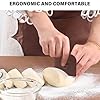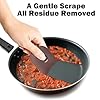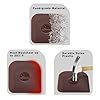Pan Scraper, 5 Pcs Pot Scraper Plastic, Pot Scraper Non Scratch for Cast Iron, Pot and Pan Cleaning, Sturdy Scraper Kitchen Tool
$5.99 ($1.20 / count) (as of November 12, 2025 10:22 GMT -05:00 - More infoProduct prices and availability are accurate as of the date/time indicated and are subject to change. Any price and availability information displayed on [relevant Amazon Site(s), as applicable] at the time of purchase will apply to the purchase of this product.)Ball Wide Mouth Glass Mason Jars with Lids and Bands, Used for Canning, Pickling, Juice, Jam, Jelly, Quart Size 32 Ounce (Pack of 2)
$15.99 ($8.00 / count) (as of November 12, 2025 14:52 GMT -05:00 - More infoProduct prices and availability are accurate as of the date/time indicated and are subject to change. Any price and availability information displayed on [relevant Amazon Site(s), as applicable] at the time of purchase will apply to the purchase of this product.)CAROTE Nonstick Frying Pan Skillet,Non Stick Granite Fry Pan Egg Pan Omelet Pans, Stone Cookware Chef's Pan, PFOA Free,Induction Compatible(Classic Granite, 8-Inch)
31% OffTable of Contents
- Understanding what induction ready cookware is
- Importance of magnetic base for induction compatibility
- Material considerations: stainless steel, cast iron, and more
- Checking for flat bottoms for optimal heat transfer
- Assessing cookware size and compatibility with your stove
- Evaluating handle durability and heat resistance
- Considering non-stick coatings and their longevity
- Maintenance and cleaning tips for induction cookware
- Price considerations and budget-friendly options
- Brand reputation and warranty benefits
1. Understanding what induction ready cookware is
What makes cookware induction ready?
Before diving into your shopping journey, it’s crucial to understand what makes cookware induction ready. Induction compatible cookware is specifically designed to work efficiently with induction cooktops, which use electromagnetic fields to generate heat directly in the cookware. These pots and pans must have a magnetic base to interact with the stovetop’s electromagnetic coil. If you’re unsure whether your current cookware suits induction, testing with a simple magnet can helpâif the magnet sticks firmly, it’s likely induction ready.
In 2025, more manufacturers are clearly labeling their products as induction compatible, making it easier to identify suitable options. As a rule of thumb, look for symbols or labels such as “induction compatible” or “induction ready” when shopping online or in stores. Remember, using cookware thatâs not induction ready can result in inefficient heating, uneven cooking, or damage to your stove.
This understanding forms the foundation for choosing the best induction ready cookware buying tips for your needs and ensures your investment will perform reliably in 2025 and beyond.
2. Importance of magnetic base for induction compatibility
Why a magnetic base is essential
The key feature that determines whether cookware is induction ready is its magnetic base. Induction stoves generate heat through electromagnetic induction, which requires ferromagnetic materials. Cookware with a magnetic base interacts with the electromagnetic field, producing heat directly within the pan.
In 2025, selecting cookware with a strong magnetic base is more straightforward thanks to technological advancements and clearer labeling. Use a magnet test at homeâif the magnet sticks with moderate strength, your cookware will work efficiently on an induction stove. Weak or non-magnetic bases mean you’ll experience slow heating or no heat transfer at all.
High-quality induction cookware tends to have a thick, magnetic steel base that ensures durability and consistent performance. Investing in cookware with a robust magnetic layer not only guarantees compatibility but also extends the lifespan of your pots and pans.
3. Material considerations: stainless steel, cast iron, and more
Which materials are induction ready?
Material choice plays a critical role in how well your cookware performs on an induction stove. In 2025, popular induction ready materials include stainless steel, cast iron, and certain enameled options. Each has its benefits and considerations.
Stainless steel is favored for its durability, non-reactivity, and compatibility with induction, especially when it contains a layered magnetic base. Cast iron excels due to its magnetic properties, excellent heat retention, and versatility. However, cast iron tends to be heavier and requires more maintenance.
4. Checking for flat bottoms for optimal heat transfer
Why flat-bottomed cookware matters
One common mistake when buying induction cookware is overlooking the bottom design. Flat bottoms ensure maximum contact with the induction cooktop, which translates to even heating and energy efficiency. In 2025, manufacturers increasingly focus on flat, smooth bases to enhance user experience.
If the cookware has a warped or rounded bottom, heat transfer becomes uneven, leading to hot spots and potentially burned food. Always inspect the cookware for flatnessâthis can often be tested at home by placing it on a flat surface or with a straight edge.
Investing in cookware with a flat, smooth base not only improves cooking performance but also reduces wear and tear on your cooktop. For best results, choose induction-ready cookware with a sturdy, flat bottom that spans the entire base for optimal heat conduction.
5. Assessing cookware size and compatibility with your stove
Selecting the right size for your induction cooktop
In 2025, the variety of induction cooktops on the marketâfrom single burners to large rangesâmeans you need to consider the size of your cookware carefully. The diameter of pots and pans should match the size of heating zones to maximize efficiency. For example, if your cooktop has a 12-inch zone, using a pot that’s significantly smaller or larger can lead to uneven heating.
Many induction cooktops have adjustable size zones or indicators to help you select compatible cookware. Check your stoveâs specifications and match them with your cookware sizes. Also, consider your cooking needsâlarge stockpots for soups and small fry pans for eggsâensuring your cookware set covers all essential sizes.
In 2025, innovative cookware lines offer adjustable bases or modular designs that fit various zone sizes, allowing more flexibility and efficiency. Ensuring proper size compatibility is a straightforward yet crucial step in your induction cookware buying tips.
6. Evaluating handle durability and heat resistance
Why handle quality impacts overall cookware performance
Cookware handles are often overlooked but play a vital role in safety and comfort. In 2025, heat-resistant, sturdy handles made from materials like silicone, Bakelite, or stainless steel are preferred. These materials ensure the handles remain cool during cooking, reducing accidents and spills.
Additionally, handles should be securely attached with rivets or welding to withstand regular use. Weak or loose handles can pose safety hazards and may need replacement sooner. Modern cookware also features ergonomic designs that provide a comfortable grip and better balance.
Choosing durable, heat-resistant handles enhances your cooking experience, especially during prolonged tasks like simmering or boiling. Remember, investing in high-quality handles is an essential part of the induction ready cookware buying tips in 2025.
7. Considering non-stick coatings and their longevity
The pros and cons of non-stick surfaces
Non-stick coatings can make cooking and cleaning easier, especially in 2025 where ceramic and PTFE coatings are prevalent. When selecting induction ready cookware with non-stick surfaces, look for high-quality coatings designed to last for years.
While non-stick pans offer convenience, their coatings may wear over time, especially when exposed to high heats or metal utensils. Many brands now use ceramic or diamond-infused non-stick coatings that are more durable and environmentally friendly.
For the best longevity, always follow manufacturer care instructionsâuse non-metal utensils, avoid high heats, and clean gently. Including a few high-quality non-stick options in your set can complement your induction cookware collection perfectly.
8. Maintenance and cleaning tips for induction cookware
Keeping your cookware in top condition
Proper maintenance extends the lifespan of induction ready cookware. In 2025, many brands offer dishwasher-safe options, but hand washing is often recommended to preserve coatings and finishes. Use mild detergents and soft sponges to avoid scratching the surfaces.
Regularly inspect for warping, especially if you notice uneven heating. Removing mineral deposits or burnt-on residues keeps your cookware performing optimally. For stainless steel, a mixture of vinegar and baking soda can help restore shine and remove stains.
Storing your cookware properlyâstacking with soft liners or hangingâis also vital to prevent damage. A little regular care goes a long way in preserving your investment in induction ready cookware.
9. Price considerations and budget-friendly options
Getting the best value for your money
In 2025, the market offers a wide range of induction ready cookware at various price points. While premium brands provide longevity and advanced features, there are also affordable options that perform reliably for everyday use.
Assess your cooking habits and choose cookware that fits your budget but still meets quality standards. Features like layered bases, sturdy handles, and durable coatings are worth investing in, but you can find budget-friendly options with good INDUCTION compatibility.
Remember, the cheapest options may not always be the most durable. Use comparison shopping, read reviews, and look for warranties when possible to ensure you’re making an informed purchase aligned with your needs.
10. Brand reputation and warranty benefits
Why trusted brands matter in 2025
Choosing from reputable brands can save you headaches later. In 2025, many leading manufacturers offer warranties that cover manufacturing defects and performance issues, providing peace of mind. Well-known brands also tend to adhere to higher safety and quality standards.
Research customer reviews and expert opinions to gauge reliability. Brands with a long history of producing induction ready cookware are more likely to provide consistent quality and excellent customer service.
Finally, warranties and after-sales support are vitalâespecially when investing in higher-end cookware. This is a key component of the induction ready cookware buying tips to help you make a smart, long-lasting purchase.
Frequently Asked Questions
1. What are the most important induction ready cookware buying tips?
The most crucial tips include verifying magnetic bases, choosing the right material, ensuring flat bottoms, and selecting reputable brands with warranties.
2. How can I test if my cookware is induction ready?
Use a simple household magnetâif it sticks firmly to the bottom of the pan, it’s likely induction compatible. Alternatively, check for labeling on the product.
3. Are non-stick induction cookware options reliable in 2025?
Yes, many high-quality non-stick coatings, such as ceramic or diamond-infused options, now offer excellent durability and are suitable for induction stovetops when properly maintained.
4. How do I ensure my induction cookware lasts longer?
Follow manufacturer care instructions, avoid metal utensils, clean gently, and store properly. Regular inspection and maintenance also prolong lifespan.
5. Why is brand reputation important for induction ready cookware buying tips?
Trusted brands offer better quality, warranty, and customer service, ensuring your investment remains effective and safe for years to come.
Conclusion
In 2025, mastering the art of choosing induction ready cookware is essential for efficient and safe cooking on modern induction stoves. By following the induction ready cookware buying tips outlined aboveâsuch as verifying magnetic bases, material choices, and ensuring flat bottomsâyou can make informed decisions that enhance your culinary experience. Remember, investing in quality cookware tailored to induction technology ensures you get the most out of your stove while enjoying durability, safety, and excellent performance. Happy cooking!

















